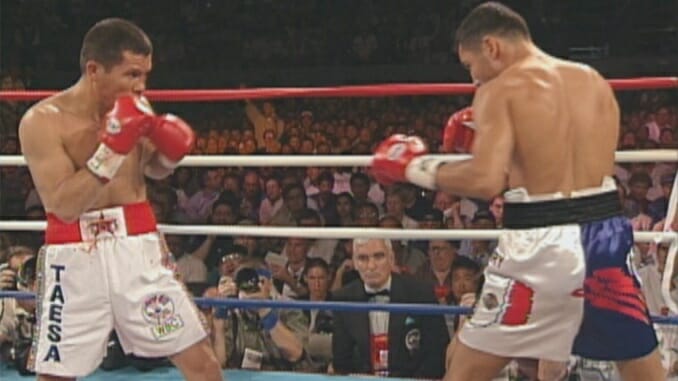Conventional Underdog Doc La Guerra Civil Still Sheds Plenty of Insight

Cultural and generational tensions come to blows in Eva Longoria Bastón’s documentary debut, La Guerra Civil. The film recounts the 1996 “Ultimate Glory” boxing match between Julio César Chávez and Oscar De La Hoya, two Mexican fighters who seemed to represent polarizing images of national identity. Though both fighters were of full-blooded Mexican heritage, the broader Mexican and Mexican-American communities resented De La Hoya for his American citizenship and pretty boy looks. The Sinaloa-born Chavez, on the other hand, was idolized as the epitome of rugged Mexican masculinity.
Incorporating talking head interviews from De La Hoya, Chávez and other prominent cultural figures (George Lopez among them), La Guerra Civil attempts to unpack the central rivalry between the two boxers while also confronting the internalized prejudices within the Mexican community, particularly concerning the sentiment surrounding De La Hoya not being “Mexican enough.” Though the then 23-year-old boxer grew up speaking Spanish with his Mexican immigrant parents, he was largely derided for being a “pocho” by Chávez and his supporters—a derogatory term for those who are clumsy Spanish speakers and detached from their Mexican roots. This unkind perception of De La Hoya fostered a sense of betrayal in the young boxer, who felt his biggest detractor was his idol-turned-opponent Chávez. Meanwhile, the then 33-year-old Chávez saw De La Hoya as an unworthy candidate for passing the torch to. Even in the present-day interview segments, it’s clear that both boxers hold a nagging grudge over the damages done to their egos in the aftermath of the match.
An undeniable animating force in the story, the extensive use of archival footage serves a multipronged purpose in the film. It is a testament to public opinion in the lead-up to the match, chronicles the boxers’ respective rise through the ranks to stardom, and most rivetingly, it presents the anticipated fight between two fighters in their prime. The match itself is bloody, tense and steeped in personal stakes for the fighters and fans alike. The buildup to this moment is gratifying and filled with compelling anecdotes from the boxers, outlining both of their career beginnings, trajectories and struggles evenly and succinctly—despite the 10-year age gap that separates the two opponents. Each had their own adolescent hardships, as well: Chávez was one of 11 siblings and grew up in poverty, while De La Hoya was forced into competitive fighting by his father at the age of five.
-

-

-

-

-

-

-

-

-

-

-

-

-

-

-

-

-

-

-

-

-

-

-

-

-

-

-

-

-

-

-

-

-

-

-

-

-

-

-

-








































